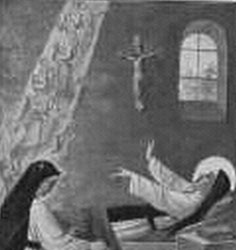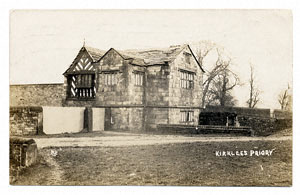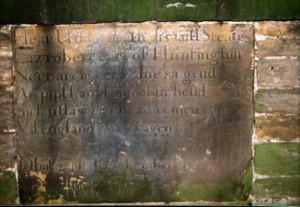Left nearly powerless by the wounds she received during the battle at the end of Immortal Warrior, Cwen the sorceress found refuge in the nunneries of England, eventually ending up at Kirklees, a Cistercian priory in the forests of what was traditionally known as the West Riding of Yorkshire. There, she worked her way up to Prioress (second to the Abbess), and that’s the point where we meet her again in Immortal Outlaw.
 The Cistercians are an order of enclosed monks founded by St. Roger of Molesme in 1098 at Cisteaux, France. They were strict followers of the Rule of St. Benedict, which called for vows of poverty, chastity and obedience, and dictated self-sufficiency and a simple life that included manual labor (St. Bernard was another famous founding member of the order.) Women were admitted to the order almost immediately, with the first nunnery opening at Langres in 1125. The nuns were known as White Ladies because of their white robes. I’ll confess right here that I screwed up on this point and talked about how Cwen liked her black robes, because they honored the old gods from whom she draws her power. Oops. I didn’t catch the mistake until well after galleys were done, and strangely, my usually perfect copy editor  didn’t catch it either. However, in our favor, the nuns did wear a black hooded surplice over the white robes (as in the image of St. Alice of Schaerbeck to the left). Perhaps we can both be forgiven.
The Cistercians are an order of enclosed monks founded by St. Roger of Molesme in 1098 at Cisteaux, France. They were strict followers of the Rule of St. Benedict, which called for vows of poverty, chastity and obedience, and dictated self-sufficiency and a simple life that included manual labor (St. Bernard was another famous founding member of the order.) Women were admitted to the order almost immediately, with the first nunnery opening at Langres in 1125. The nuns were known as White Ladies because of their white robes. I’ll confess right here that I screwed up on this point and talked about how Cwen liked her black robes, because they honored the old gods from whom she draws her power. Oops. I didn’t catch the mistake until well after galleys were done, and strangely, my usually perfect copy editor  didn’t catch it either. However, in our favor, the nuns did wear a black hooded surplice over the white robes (as in the image of St. Alice of Schaerbeck to the left). Perhaps we can both be forgiven.
Kirklees was founded in 1155, during the reign of Henry II, Â with the grant of land confirmed in 1236 by Henry III. In addition to nuns, the house was used as a sort of boarding school by local noblemen intent on keeping their daughters out of trouble. This effort had mixed success: the young noblewomen brought luxuries and a sense of fun with them that sometimes spread to the nuns, and there are several recorded incidents when nuns ran off with priests or otherwise carried on scandalously, sometimes right on priory grounds; those stories inspired both Cwen’s magic-weaving in her cell and the story of Sr. Paulina and Fr. Renaud and their clandestine affair.

Kirklees escaped the initial rounds of the Dissolution in 1535, but was eventually surrendered in 1539, when only eight nuns remained. After the inmates left, the chapter house was razed and its stones eventually were used to build Kirklees Hall nearby. However, Â the gatehouse escaped the predations and still stands today, though parts were apparently rebuilt in the intervening centuries.In the traditional Robin Hood legends, it is in that same gatehouse that Robin meets his end, bled to death by his cousin, the prioress of Kirklees, whom he sought out when ill. When he realizes his cousin has betrayed him, Robin summons help with his hunting horn. It’s too late, however, and all Little John can do is help Robin shoot an arrow out the window, promising to bury him on the spot where it fell.

A well-marked grave exists at Kirklees today, surrounded by an iron railing and showing a Victorian era headstone in pseudo-Gothic  English that claims it’s where Robin lies. Suspiciously, it lies a good 600 yards from the gatehouse — over twice the distance of a good medieval longbow shot. However, travelers to the area during the mid-16th century report visiting Robin’s grave in a different place, at about the right distance for a bowshot. And indeed, human remains were found in that spot during renovations of Kirklees Hall during the mid-18th century. It’s unclear wherther those remains were reburied at the spot now marked for Robin.
The Victorian headstone, pictured, reads:
Here underneath dis laitl stean
Laz robert earl of Huntintun
Ne’er arcir ver as hie sa geud
An pipl kauld im robin heud
Sick utlawz as his as iz men
Vil england nivr si agen
Whether Robin lies in the marked grave or not, both locations sit on private land, inaccessible to  the public. Somehow, I think it’s appropriate that Robin remains as elusive to us today as he was to the Sheriff in the 13th century.
![]()


Permalink
Hi–I loive in this area an there is a great mystery attached to all this!
Barbara
Permalink
BOSSY BISHOPS & NAUGHTY NUNS
Kirklees Priory was founded in the twelfth century by Reinor de Fleming,the manor lord of Clifton, West Yorkshire. The Rule was Cistercian and at first very strict, but as time passed, the “White Ladies‖so called because of the colour of their undyed habits–became less dedicated to the religious ideal. Many of them were the unwanted daughters of gentry with no real vocation to the cloistered life. The sisters were often admonished by visiting bishops for indulging in worldy ways , keeping dogs, trimming their habits up , going out dancing–and for inviting men onto the holy premises! In 1300 Pope Boniface VIII published a Papal Bull, PERICULOSO, which forbade such unseemly goings on, but the nuns threw the document after the bishop who came to deliver it , and chased him off the premises. In 1315 there were scandalous reports in circulation about the nuns of Kirklees. It was reported that one “Alice de Raggid, deceived by the allurements of frail flesh,in great levity of mind,hath gone forth from her house and hath wandered in great peril,having long ago put off her religious habit.†Later on, two more nuns,Elizabeth de Hopton and Joan de Heton,along with the rebellious Alice (who must have returned to the nunnery by then) were accused of admitting both clergy and laymen to “the secret places of the monastery……..from which there is suspicion of sin and great scandal arises.†No wonder Robin came to such a sticky end among such flighty creatures !
The nunnery was finally dissolved, with the other Yorkshire monasteries, by Henry V111 IN 1539, after which Kirklees Hall was built on the nearby hillside,using the stones of the fallen priory. Only the gatehouse,where Robin died, was left standing. Today ,like the grave, it is danger of being lost to our heritage as it is allowed to slowly crumble away, unchecked and unhindered by any official attempts to prevent the destruction.
The prioress who killed Robin, either intentionally or accidentally, has never been identified. Existing lists of prioresses are incomplete, plus no one knows for certain exactly when Robin died, though the pseudo medieval inscription on his Gothic-style grave states 24 December,1247. This may have been a miswriting of an earlier inscription, as 1347 is the estimated date of death for Robin Hood of Wakefield. The grave of Prioress Elizabeth de Stainton is still standing in the grounds of Kirklees, a short distance from the gatehouse, but obviously there would have been many more unexcavated graves in the area as the nuns were there for over four hundred years. A large house now stands on the priory ruins. Another known prioress was Dame Mary Startin, who was in office in 1347–maybe she was the murderess ! According to the ballads, the prioress had a lover, Red Roger of Doncaster, who helped her in her evil task, though Robin managed to rise from his deathbed and kill him before expiring !
A Victorian visitor to Robin Hood’s Grave wrote:
“I had the strangest emotions when I first stood over the grave of this old forest hero. I stood there and had no words nor can find any now to tell what my feelings were. Brave hearted Robin ! thou hast found a fit resting place in this glorious park ,among these solemn yews and silent trees.â€
If only he knew the deplorable state of the grave today !!!!
FOR FURTHER DETAILS READ “THE OUTLAW ROBIN HOOD ,HIS YORKSHIRE LEGEND†by Barbara Green
Thank you Lisa, I realise even the edited version is rather long, it is good to know the reason rather than just eb deleted. I am not sure what you are referring to specifically but hope this is okay,
barbara
Permalink
https://shorturl.fm/Quw3O